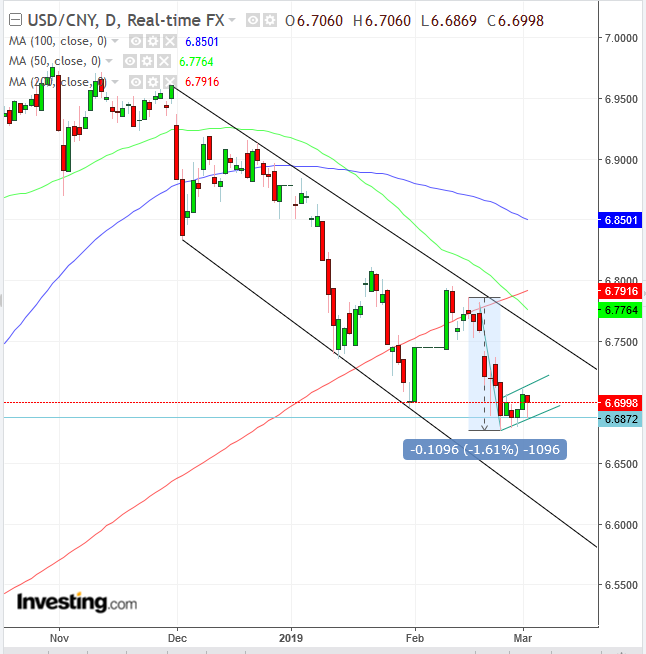A much-hoped-for trade deal between the world's two largest economies is closer than ever, and China's yuan is strengthening. An integral part of the deal is China’s concessions to play by the same rules everyone else does. With China’s growing acceptance into the global economy, one would think this would be an ideal time to buy its currency.
We don’t think so. Our reasoning is based on the technicals, and not the fundamentals. Because, if anything, China's slowing economy should hurt its currency. However, if the stated cause for its economic contraction is the trade war, it stands to reason that its resolution should boost the economy.
Maybe. But the current rise is on geopolitics, and those are fickle.

Meanwhile, the underlying market forces suggest further strengthening for the Chinese yuan. The USD/CNY pair plunged 1.6% over seven sessions, between the Feb. 15 high and the Feb. 25 low. That formed a "flag pole."
Since then, over the last five sessions, the price has been consolidating, creating the body of the flag. This is a rising flag, which, contrary to its bullish-sounding name, is a bearish pattern within a downtrend.
The presumptive dynamic is that the price isn’t rising on demand of the dollar versus the yuan, but rather because of bears who—after going on the ride of their lives in the previous drop—now need to catch their breath by cashing out, as they decide on their next move.
The fact that the rise pales in comparison to the previous drop, and is congested, suggests there's sufficient supply by new bears to absorb the temporary demand created by any bears exiting short positions. The downside breakout of the pattern would signal another sharp drop—generally following a return move, to retest the pattern’s resistance—pulling the earlier bears back into another hoped-for lucrative short.
Adding weight to the bearish argument: it follows the pattern of the falling channel since December, bouncing off its bottom in corrective mode, only to keep falling soon afterward. Another piece of evidence is the price’s failure to remain above the 200 DMA after three attempts in February.
Also, the 50 DMA fell below the 200 DMA, triggering a Death Cross, ominously suggesting what will happen to bulls. Moreover, the much-noted technical signal—even among non-technicians—occurred right above the falling channel, demonstrating its significance in the market flow.
Finally, the most convincing technical phenomenon is the new trough the flag formed within the downtrend, extending it.
Trading Strategies
Conservative traders would wait for a 3% downward penetration of the flag, to limit the potential of a bear trap, followed by a return move which successfully tests the pattern’s integrity, with at least one long, green candle engulfing a red or small candle of either color.
Moderate traders may be content with a 2% downside breakout as a filter, followed by a return move for a better entry but not necessarily for proof of the trend’s integrity.
Aggressive traders may short now.
Trade Sample
- Entry: 6.7020
- Stop-Loss: 6.7120, above Friday’s high
- Risk: 100 pips
- Target: 6.6020
- Reward: 1,000 pips
- Risk-Reward Ratio: 1:10
